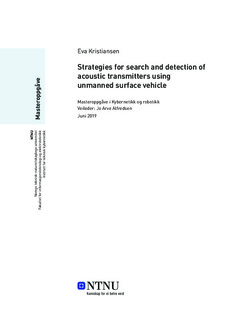| dc.contributor.advisor | Alfredsen, Jo Arve | |
| dc.contributor.author | Kristiansen, Eva | |
| dc.date.accessioned | 2019-10-31T15:07:41Z | |
| dc.date.issued | 2019 | |
| dc.identifier | no.ntnu:inspera:35771502:17315529 | |
| dc.identifier.uri | http://hdl.handle.net/11250/2625709 | |
| dc.description.abstract | Denne oppgåva tar for seg baneplanlegging i forbindelse med søk etter akustiske sendarar.
Akustisk telemetri har gjort store framsteg dei siste åra, i samband med miniatyrisering
av elektronikk. Signal frå akustiske sendarar i fisk registrerast av mottakarar som er festa
i stasjonære bøyer, eller i ulike bevegelige plattformar. I denne oppgåva er målet å lage
strategiar for å effektivt gjennomsøkje eit område for slike akustiske sendarar ved hjelp av
eit autonomt overflatefartøy.
Søkjeproblemet vert formulert i et diskret kart, og tre ulike metodar vert implementert
og testa i simulasjon. Den første metoden er ein metode som prøver å dekkje så mykje
som mulig av området. Den andre metoden er ein grådig metode, og velgjer heile tida
retningar som lokalt optimaliserer sannsynet for deteksjon av fisk. Den tredje metoden er
ein tilfeldig strategi med inspirasjon frå biologien.
I simulasjon er begge dei systematiske stiane merkbart betre enn den tilfeldige, i den forstand
at dei finn fleire akustiske sendarar på same tid. Den grådige metoden er litt betre
enn den dekkjande metoden i dei tilfella der den grådige metoden har riktig informasjon
og måla er i bevegelse.
Ein Matlab-applikasjon som kan lage dekkjande stiar for eit geografisk område er implementert
i forbindelse med denne oppgåva. Denne applikasjonen kan sende veipunkt til
Neptus, som er eit kontrollsenter for styring av autonome farkostar. | |
| dc.description.abstract | This thesis considers path planning for search and detection of acoustic transmitters. In
fish telemetry, signals from acoustic transmitters attached to fish are registered. Recent
advances in acoustic telemetry systems combined with the growing availability of autonomous
systems is predicted to increase the yield of biological data from fish telemetry
and our understanding of fish ecology. In this thesis, the goal is to devise paths for an
unmanned surface vessel that efficiently search an area for acoustic transmitters.
The search problem is formulated in a discrete map, and three different methods for path
planning are implemented and tested in simulation. The first method is a path that aims to
cover the search area. The second method is a greedy path planner, that aims to maximise
the local probability of detection at each step. The third method is a random path generator
inspired by biology.
Both systematic paths have better performance than the randomised one in simulations
in terms of finding the most targets. The greedy method performs slightly better in the
case where it has the correct information and the targets are moving.
A MatLab-application was also made within the scope of this thesis. The application calculates
paths that aim to cover an area, and broadcasts the paths as way-points to Neptus,
which is a control centre for autonomous vessels. | |
| dc.language | eng | |
| dc.publisher | NTNU | |
| dc.title | Strategies for search and detection of
acoustic transmitters using
unmanned surface vehicle | |
| dc.type | Master thesis | |
